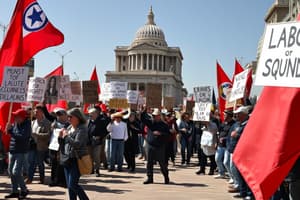Podcast
Questions and Answers
¿Qué son las huelgas por prácticas laborales injustas?
¿Qué son las huelgas por prácticas laborales injustas?
Son protestas legales contra presuntos actos ilícitos del empleador.
¿Qué tipos de huelgas no están protegidas bajo la Ley Nacional de Relaciones Laborales (NLRA)?
¿Qué tipos de huelgas no están protegidas bajo la Ley Nacional de Relaciones Laborales (NLRA)?
Huelgas salvajes, huelgas de sentada, huelgas parciales o de trabajo lento, violencia en piquetes y boicots secundarios.
¿Qué son las huelgas parciales?
¿Qué son las huelgas parciales?
Son detenciones parciales del trabajo donde los empleados retiran sus servicios de manera parcial en lugar de completa.
¿Qué tipo de huelgas son las huelgas económicas?
¿Qué tipo de huelgas son las huelgas económicas?
¿Qué es un 'slowdown' en el contexto de las huelgas laborales?
¿Qué es un 'slowdown' en el contexto de las huelgas laborales?
¿Qué ley en los Estados Unidos rige los conflictos laborales?
¿Qué ley en los Estados Unidos rige los conflictos laborales?
¿Cuáles son algunos factores que determinan la legalidad de las huelgas parciales?
¿Cuáles son algunos factores que determinan la legalidad de las huelgas parciales?
¿Qué consecuencias pueden enfrentar los empleados que violan cláusulas de un contrato colectivo relacionadas con las huelgas?
¿Qué consecuencias pueden enfrentar los empleados que violan cláusulas de un contrato colectivo relacionadas con las huelgas?
¿Por qué es importante que los contratistas documenten el impacto de las huelgas en los proyectos?
¿Por qué es importante que los contratistas documenten el impacto de las huelgas en los proyectos?
¿Qué deben hacer los trabajadores si un contrato limita las huelgas?
¿Qué deben hacer los trabajadores si un contrato limita las huelgas?
¿Qué les ayuda a los empleadores a evitar conflictos potenciales relacionados con las huelgas?
¿Qué les ayuda a los empleadores a evitar conflictos potenciales relacionados con las huelgas?
¿Cómo pueden todas las partes involucradas trabajar hacia una resolución mutuamente beneficiosa durante una huelga?
¿Cómo pueden todas las partes involucradas trabajar hacia una resolución mutuamente beneficiosa durante una huelga?
Flashcards are hidden until you start studying
Study Notes
Work Stoppages and Suspensions
Work stoppages, including partial strikes and slowdowns, are common forms of labor action taken by workers to assert their rights and negotiate better working conditions. While these actions can disrupt workflows and productivity, understanding the legal framework governing work stoppages helps employers and employees navigate potential conflicts.
Legal Background
Under the National Labor Relations Act (NLRA) in the United States, labor disputes are governed by various labor laws. Two main types of strikes are recognized:
- Unfair labor practice strikes: These are lawful protests against alleged unlawful acts of the employer, such as refusing to bargain with the union or discharging employees for union activities.
- Economic strikes: These are lawful protests for reasons other than unfair labor practices, like wage increases or benefit program improvements.
However, certain types of strikes, like wildcat strikes, sit-down strikes, partial/slowdown strikes, picket line violence, and secondary boycotts, are not protected under the NLRA.
Partial Strikes and Slowdowns
Definition
Partial strikes refer to work stoppages where workers withdraw their services partially rather than completely, often in a coordinated manner. This can include slowdowns, which involve reducing productivity without stopping work entirely.
Legal Consequences
The legality of partial strikes depends on various factors, including the specific circumstances surrounding the strike and the applicable laws. In some cases, partial strikes may be considered an unprotected concerted activity that is neither a protected nor an unprotected activity under the National Labor Relations Act.
Collective Bargaining Agreements
In the context of collective bargaining agreements, strikes may be governed by provisions related to the timing and duration of work stoppages. Violating these terms could lead to disciplinary actions against the striking employees. If a contract contains clauses limiting strikes, workers must adhere to these restrictions.
Impact on Projects and Contractors
Labor strikes can cause delays and increased costs for construction projects and other industries. In response, contractors should maintain records documenting the impact of strikes on projects, as this evidence is crucial when making delay claims.
In conclusion, understanding the legal framework governing work stoppages helps employers navigate potential conflicts while ensuring workers' rights are respected. By being aware of the different types of strikes, their legal consequences, and the role of collective bargaining agreements, all parties involved can work towards a mutually beneficial resolution.
Studying That Suits You
Use AI to generate personalized quizzes and flashcards to suit your learning preferences.




